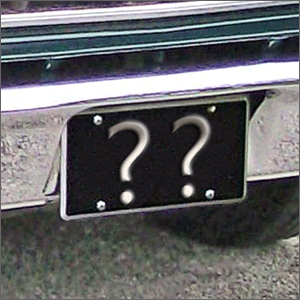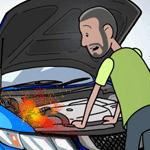Pages
|
RockAuto now carries GKN Automotive. GKN is the global leader in OE Drivetrain components and systems, supplying car manufacturers all over the world. GKN's OE expertise translates to premium quality aftermarket replacement Drive Shafts, CV Axles, CV Joints and CV Joint Boots. GKN's Thermoplastic (TPE) CV Joint Boots are designed to withstand high temperatures caused by the high torque transmitted in modern drive systems - this results in longer boot life, increased impact resistance and rotational stability. Find these parts and more in the "Drivetrain" category of the RockAuto.com catalog. | |

| |
 | |
 I installed new front rotors and pads from RockAuto on my 2014 Cadillac XTS. A week later, after driving a few hundred miles, the ABS light came on. What did I do to mess up the ABS?! A scan tool said it was a left front wheel speed sensor. In the past, this happened when the magnetic encoder ring on the wheel bearing/hub corroded but this hub was replaced only a couple of years ago. Maybe some metal or brake dust contaminated the ring from the brake job, but itís not easy to see the ring without taking off the hub. Thinking there might be some corrosion in the wires or a bad sensor, I ordered a new sensor and wires from RockAuto. Nope, that wasnít it. It had to be the hub so off it came and was replaced with a new Timken, even though the old hub looked OK. Still got the ABS light! Finally thinking it had to be a wiring problem, I pulled back the fender lining and out falls an acorn! You guessed it, a mouse or squirrel had chewed through the wires further back out of sight! It was just a coincidence that it happened right after the brake job. Ray in Rhode Island Share Your Story |
|
 New catalytic converters fail most often because the engine problem (unburned fuel, leaked engine oil...) that destroyed the old catalytic converter was never fixed. Not performing a proper break-in can be another way to damage a new catalytic converter. Here is a typical break-in procedure recommended by a respected catalytic converter manufacturer: After all repairs have been made and the monitors have been reset, start the engine and allow it to idle and warm up slowly for 5 minutes. Do not rev the engine or deviate from an idle condition for 5 minutes. Then hold engine at 2,000 RPM for two minutes. Turn off engine and allow to cool down for 10 minutes. The converter matting is now set and ready for service. Proper formation of the "converter matting" is the main objective of a proper break-in. The converter matting surrounds and protects the fragile ceramic catalyst brick that does the work of the catalytic converter. Matting typically starts out as a mineral called vermiculate packed inside a paper-like shell. The catalyst brick is wrapped in the matting and placed inside the catalytic converter's metal housing. The matting may not snuggly fill all the gaps around the brick until it is heated during break-in.  Cross Section of Catalytic Converter Matting Similar to popcorn, vermiculite contains moisture that causes it to dramatically expand when heated. The recommended break-in cycle first burns the paper-like shell off the vermiculite. The now loose vermiculite begins to expand as the increasing heat turns moisture into steam. The expanded vermiculite fills in the gaps between the catalyst brick and the surrounding metal housing. The ceramic catalyst brick ends up safely swaddled inside a layer of expanded vermiculite. The break-in procedure heats up the vermiculate and then gives it enough time to expand. If the vermiculite is heated excessively then it might expand too rapidly and form oddly shaped chunks with air gaps in between (shattered and burnt popcorn). If the vermiculite isn't heated enough, then all the moisture may evaporate away slowly without adequately expanding the vermiculite (dried out/baked popcorn). Both too much heat or too little heat during the break-in period can lead to a catalyst ceramic brick and chunks of vermiculite rattling around inside the catalytic converter's metal housing. Exhaust will be able to leak around the catalyst brick, and all the rattling may eventually break the ceramic brick apart. Some catalytic converter manufacturers have optimized their converter matting (particle size, moisture levels, paper-like shell material...) and manufacturing processes (packing tightness, air gap sizes...) to a point where they can say a specific break-in procedure is no longer necessary. A repair shop may be able to save money if technicians do not have to spend any time consciously performing a break-in procedure. The most successful popcorn makers methodically follow the same process no matter what brand of popcorn kernels they happen to have today. Similarly, both the DIYer and the cautious professional technician might want to play it safe and put every catalytic converter through a break-in cycle. It never hurts, and it might prevent having to replace a new catalytic converter. Be sure to follow instructions in the vehicle's repair manual and/or that came with a new catalytic converter. See the catalytic converters available for your specific vehicle under "Exhaust & Emission" in the RockAuto.com catalog. Tom Taylor, To read more of Tom's articles, click this link and choose from story titles on the Newsletter Archives page. |
|
 |
|
This is the 1985 Porsche 924S that my wife and I acquired three years ago. This has always been my wife's dream car, and we finally made it a reality with the help of RockAuto. RockAuto has been a great resource for us for everyday wear items and harder to find cosmetic parts. So far, we have purchased clutch master and slave cylinders, sunroof drive gears, control arm bushings, door seals, sunroof seals, trunk seals, and a dashboard cover. We have more work to do, and we'll be returning to RockAuto for the great bargains and quality parts we need to get it done. Thanks for your
great service, timely shipping, and fair prices! |
Share Your Hard Work & Stories | |
|
Your Hard Work Do you purchase parts from RockAuto? If so, RockAuto would like to give you the opportunity to have your car or truck possibly featured in one (or occasionally more) of our publications such as the monthly newsletter, collector magnets or other commercial use. New, old, import, domestic, daily driver, trailer queen, classic, antique, we want to see them all! For submission instructions and tips for taking pictures of your car, please visit our Photography Tips & Submission Info page. Your Most Infamous Auto Repair Blunder Use your woe to help others avoid similar mistakes. Please email your story to marketing@rockauto.com. Include your mailing address and if you would like a RockAuto Hat if we publish your story. See the Hats under Tools & Universal Parts in the RockAuto catalog. The story will be credited using only your first name and your vague geographic location (state, province, country, continent, etc.) so you can remain semi-anonymous! | |